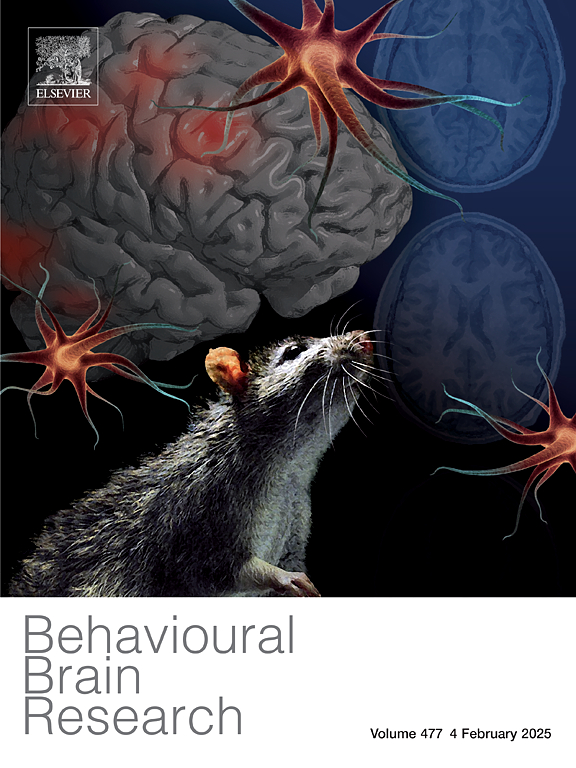长期间歇性禁食诱导CD-1小鼠星形胶质细胞形态和表达以及焦虑样行为的区域和性别特异性变化
IF 2.3
3区 心理学
Q2 BEHAVIORAL SCIENCES
引用次数: 0
摘要
间歇性禁食(IF)是一种代谢干预,可改变系统和大脑能量动力学,促进神经化学和细胞适应,从而影响情绪和情绪调节。星形胶质细胞作为脑代谢、神经递质清除和神经炎症过程的关键调节因子,对营养可利用性的波动特别敏感。星形细胞形态和胶质纤维酸性蛋白(GFAP)表达的失调与焦虑的病理生理有关。然而,IF对星形胶质细胞完整性和行为的长期影响仍然知之甚少。本研究研究了在出生后60天(PD)开始的为期6周的16:8 IF方案如何调节雄性和雌性CD1小鼠参与情绪和稳态处理的大脑区域的星形细胞形态和GFAP表达,包括内侧前额叶皮质(mPFC)、岛叶皮质(IC)和杏仁核(AM)。使用开放场地测试(OFT)、高架迷宫(EPM)和光暗测试(LDT)评估pd 102-103 的焦虑样行为。免疫组织化学和肖尔分析用于量化星形胶质细胞数量,细胞质面积和分支复杂性。它增加了类似焦虑的行为,尤其是在EPM中。观察到区域和性别特异性星形细胞重塑:IF减少了mPFC的细胞质面积和分支,诱导了IC的适度变化,并在AM中产生了gmap阳性星形细胞密度和近端树突的显著增加。值得注意的是,焦虑指数与AM中的星形胶质细胞数量正相关,表明神经胶质反应性与代谢应激的情绪反应之间存在潜在联系。这些发现强调了杏仁核是星形胶质细胞对IF敏感的关键部位,并强调了脑区域和性别作为胶质细胞适应调节剂的重要性。本文章由计算机程序翻译,如有差异,请以英文原文为准。
Long-term intermittent fasting induces region- and sex-specific changes in astrocyte morphology and expression and anxiety-like behaviors in CD-1 mice
Intermittent fasting (IF) is a metabolic intervention that alters systemic and cerebral energy dynamics, promoting neurochemical and cellular adaptations that may influence mood and emotional regulation. Astrocytes, as key regulators of brain metabolism, neurotransmitter clearance, and neuroinflammatory processes, are particularly sensitive to fluctuations in nutrient availability. Dysregulation of astrocytic morphology and glial fibrillary acidic protein (GFAP) expression has been implicated in the pathophysiology of anxiety. However, the long-term effects of IF on astrocyte integrity and behavior remain poorly understood. This study examined how a six-week 16:8 IF protocol, initiated at postnatal day (PD) 60, modulates astrocytic morphology and GFAP expression in brain regions involved in emotional and homeostatic processing, including the medial prefrontal cortex (mPFC), insular cortex (IC), and amygdala (AM), in male and female CD1 mice. Anxiety-like behavior was assessed on PDs 102–103 using the Open Field Test (OFT), Elevated Plus Maze (EPM), and Light-Dark Test (LDT). Immunohistochemistry and Sholl analysis were used to quantify astrocyte number, cytoplasmic area, and branching complexity. IF increased anxiety-like behavior, particularly in the EPM. Region- and sex-specific astrocytic remodeling was observed: IF reduced cytoplasmic area and branching in the mPFC, induced modest changes in the IC, and produced robust increases in GFAP-positive astrocyte density and proximal arborization in the AM. Notably, anxiety indices positively correlated with astrocyte number in the AM, suggesting a potential link between glial reactivity and emotional responses to metabolic stress. These findings highlight the amygdala as a key site of astrocytic sensitivity to IF and underscore the importance of brain region and sex as modulators of glial adaptation.
求助全文
通过发布文献求助,成功后即可免费获取论文全文。
去求助
来源期刊

Behavioural Brain Research
医学-行为科学
CiteScore
5.60
自引率
0.00%
发文量
383
审稿时长
61 days
期刊介绍:
Behavioural Brain Research is an international, interdisciplinary journal dedicated to the publication of articles in the field of behavioural neuroscience, broadly defined. Contributions from the entire range of disciplines that comprise the neurosciences, behavioural sciences or cognitive sciences are appropriate, as long as the goal is to delineate the neural mechanisms underlying behaviour. Thus, studies may range from neurophysiological, neuroanatomical, neurochemical or neuropharmacological analysis of brain-behaviour relations, including the use of molecular genetic or behavioural genetic approaches, to studies that involve the use of brain imaging techniques, to neuroethological studies. Reports of original research, of major methodological advances, or of novel conceptual approaches are all encouraged. The journal will also consider critical reviews on selected topics.
 求助内容:
求助内容: 应助结果提醒方式:
应助结果提醒方式:


